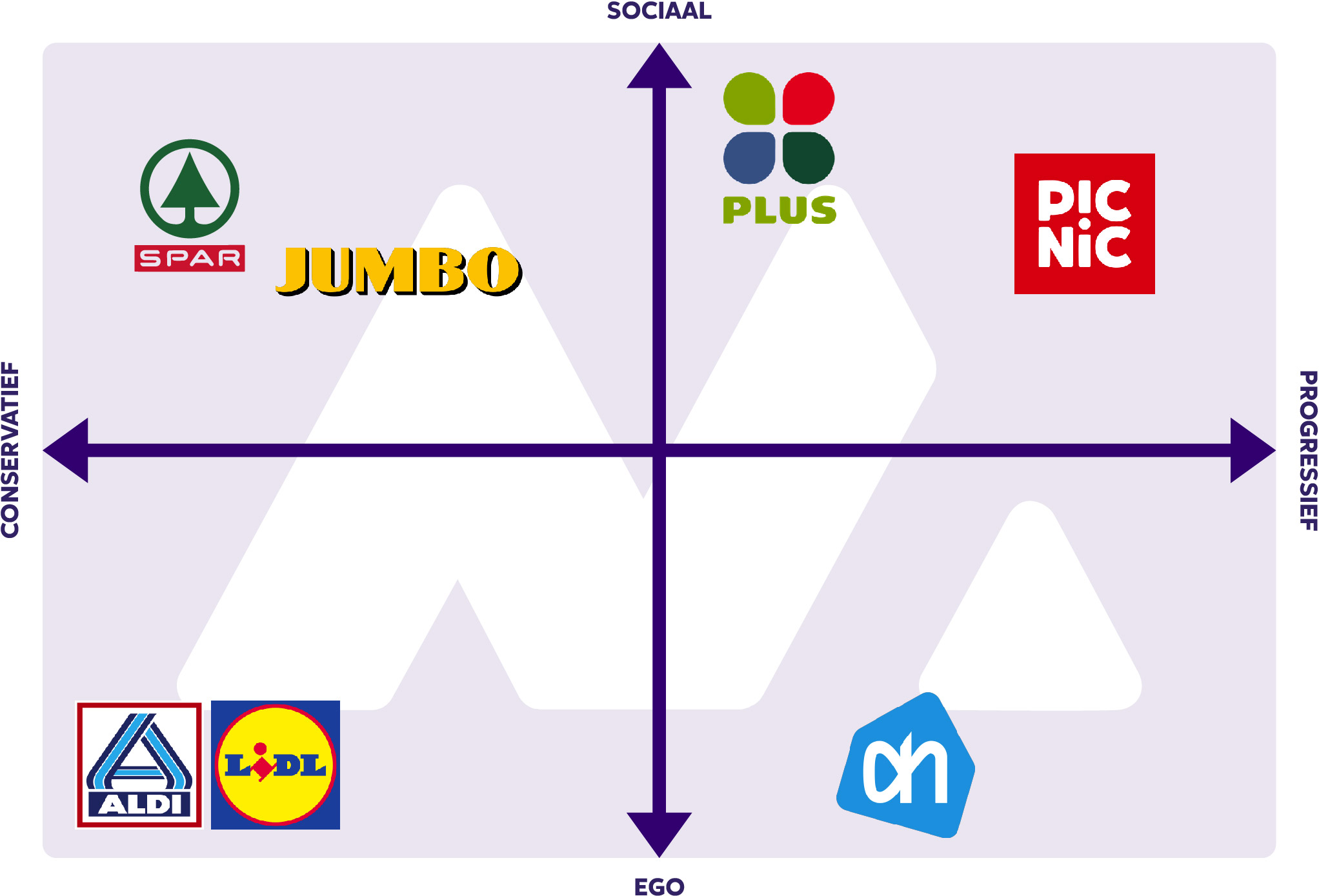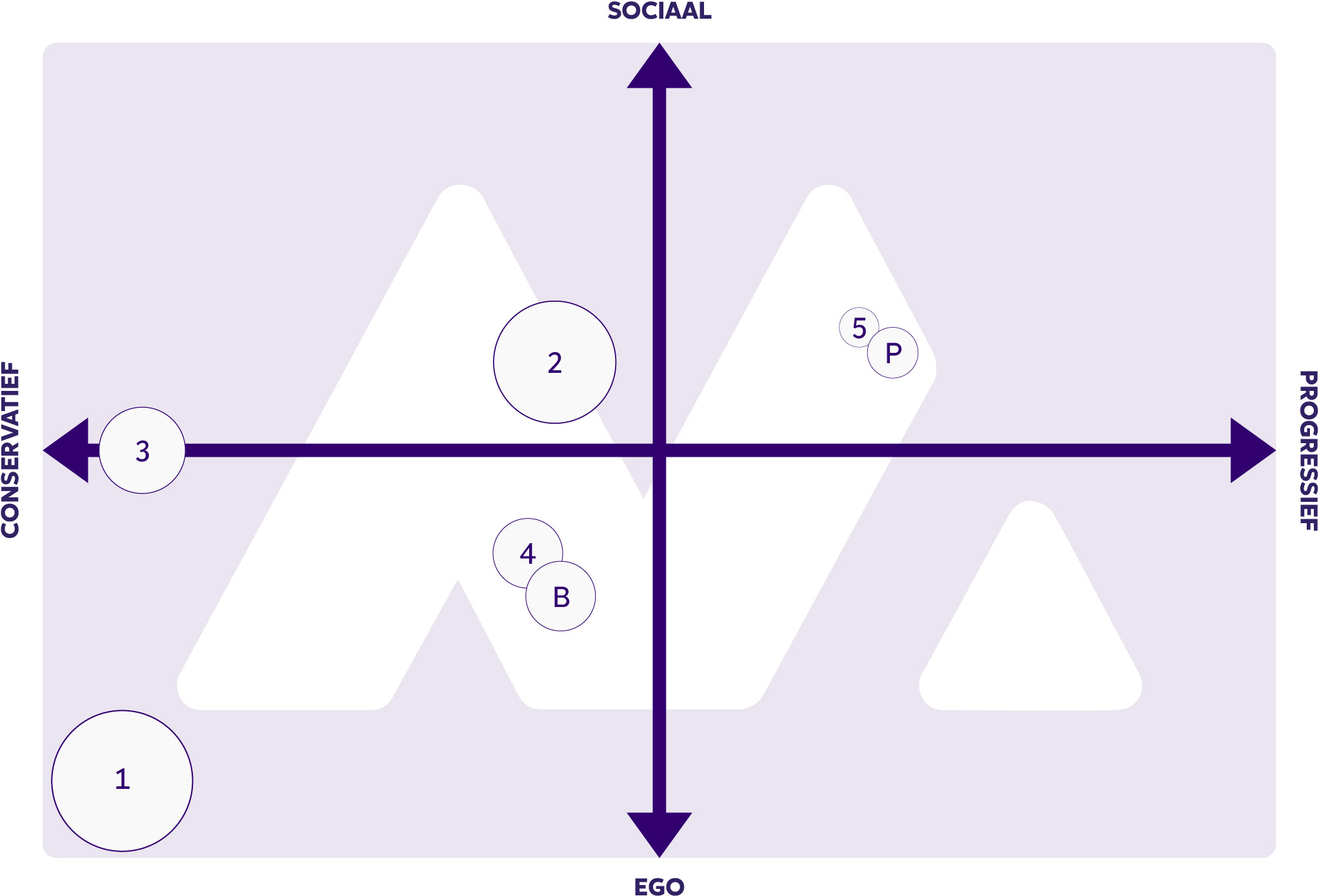*Positioneren
Positioneringsmatrix maken voor je merk: uitleg en voorbeelden

Wil jij een positioneringsmatrix maken voor jouw merk? In dit artikel leggen we aan de hand van een praktijkvoorbeeld uit hoe je een positioneringsmatrix maakt, invult en gebruikt om tot een onderscheidende positionering te komen voor jouw merk.
Positioneringsmatrix betekenis en definitie
De definitie van positioneringsmatrix is:
Een positioneringsmatrix is een strategisch instrument waarmee een merk haar positionering ten opzichte van de concurrentie kan bepalen en kansen voor onderscheidend vermogen kan identificeren.
Wat is een positioneringsmatrix
Een positioneringsmatrix is een matrix, een rechthoek met daarin één horizontale en één verticale as. Deze assen vertegenwoordigen de twee belangrijkste elementen van onderscheidend vermogen in de markt en worden gebruikt om merken of bedrijven te plaatsen. Ook snijden de assen de matrix in stukken waardoor kwadranten ontstaan en merken te categoriseren zijn. De plek in de matrix geeft natuurlijk de positionering van een merk weer ten opzichte van de concurrentie.
Positioneringsmatrix Kotler
De positioneringsmatrix van Kotler – een van de grondleggers van hedendaagse marketing – is nog steeds een veelgebruikte variant. Prijs en kwaliteit zijn de assen waarop hij de merken indeelt en dat ziet er bijvoorbeeld als volgt uit:

Kotler positioneringsmatrix: prijs en kwaliteit zijn de assen
Kotler, en een groot deel van de marketingliteratuur, baseert zich op de marketing van consumentenproducten, specifiek Fast Moving Consumer Goods (FMCG) zoals bijvoorbeeld wasmiddel. Dit is voor hedendaagse merken waarschijnlijk niet de juiste positioneringsmatrix om te hanteren. Tenzij je ook wasmiddel of vruchtensap verkoopt is jouw concurrentiespeelveld waarschijnlijk wat complexer dan prijs en kwaliteit.
Waarom een positioneringsmatrix maken?
We maken een positioneringsmatrix om kansen voor onderscheidend vermogen te vinden ten opzichte van onze concurrentie. Dat moet ervoor zorgen dat wij bijvoorbeeld een groter marktaandeel of betere marge realiseren.
Maar de grootste kansen voor onderscheidend vermogen draaien niet om procentuele prijsverschillen of een iets hogere kwaliteit. De grootste kansen voor onderscheidend vermogen vind je als je jouw product of dienst opnieuw uitvindt. Apple vond de mobiele telefoon opnieuw uit, Tesla wist ons idee van elektrisch rijden op zijn kop te zetten. Dit zijn nu twee van de meest waardevolle merken ter wereld. Ook in B2B geldt dit principe, IBM vindt zichzelf ook telkens opnieuw uit en verandert waar zij voor vecht.
In het boek Blue Ocean Strategy stelt INSEAD professor W. Chan Kim dat merken niet hun concurrentie moeten willen verslaan maar juist een nieuw markt moeten creëren waarin zij de onbetwiste leider zijn. Denk aan het traditionele circus en Cirque du Soleil, het is allebei circus in een tent maar je zult het met ons eens zijn dat de twee concepten mijlenver uit elkaar liggen.
Vat je dat verschil van positionering op de assen prijs en kwaliteit?
Positioneringsmatrix assen

Samsung en Apple: twee merken die anders aankijken tegen onderscheidend vermogen in dezelfde markt
De assen van de positioneringsmatrix worden natuurlijk bepaald door jou. Welke factoren zijn de belangrijkste elementen voor onderscheidend vermogen in jouw markt? En dit maakt de assen meteen de grootste valkuil bij het gebruik van de positioneringsmatrix.
Voor Apple’s draait onderscheidend vermogen waarschijnlijk om design en gebruiksgemak terwijl Samsung’s mobiele divisie zal praten over camera en schermkwaliteit. Beide bedrijven zijn leidend in hun eigen matrix maar Apple mag het grootste deel van de winst bijschrijven. Welke matrix geeft dan het best weer wat in de markt onderscheidend vermogen vertegenwoordigd?
Positioneringsmatrix bedrijf
In het geval van een bedrijfs-strategisch vraagstuk stoppen wij voor onze opdrachtgevers daarom altijd veel tijd in het bepalen van de juiste assen voor de positioneringsmatrix. We analyseren de concurrentie en beschikbare marktinformatie om te bepalen wat de (toekomstige) belangrijkste factoren voor onderscheidend vermogen zijn. In overleg met de opdrachtgever bepalen we dan de assen.
Het komt in dit soort situaties ook vaak voor dat we meerdere positioneringsmatrices opstellen zodat de opdrachtgever het marktbeeld kan toetsen. Dit helpt bijvoorbeeld bij het nemen van strategische beslissingen op het gebied van investeringen, productontwikkeling en acquisities.
Positioneringsmatrix marketing: objectiviteit cruciaal
Maar meestal heeft een opdrachtgever behoefte aan een marketing positioneringsmatrix. Daarmee brengen we de kaart vanuit puur marketingperspectief in kaart met als doel het bepalen van de gewenste marketingstrategie. In dit geval worden veel bedrijfsstrategische keuzes en uitgangspunten voor waar aangenomen.
Objectiviteit is in dit geval een groot goed. Elk team heeft oogkleppen op waar het gaat om hun eigen merk en een rode waas als het gaat om de concurrentie. Terwijl het draait om hoe de doelgroep naar hun merk kijkt. Wij hanteren daarom bijna altijd dezelfde assen bij een marketing positioneringsmatrix: middel en boodschap. De Positioneringsmatrix ziet er dan als volgt uit:

Een lege Merkelijkheid Positioneringsmatrix
Vergis je niet, er zijn genoeg extreem succesvolle merken te noemen die zich prima thuis voelen in het Ego/Conservatief kwadrant. Het gaat er niet om waar jouw merk zich in het model bevindt maar juist of het daarin een geheel eigen positie heeft gevonden. Objectief kijken naar je eigen merk en markt is lastig, daarom hebben wij gekozen voor de volgende assen:
Positioneringsmatrix as: Middel/medium
De horizontale as loopt van conservatief naar progressief, dit slaat op de manier waarop je marketing bedrijft. Maak het merk gebruik van nieuwe technieken en technologie, probeert het nieuwe dingen of is het op een ander vlak vooruitstrevend? Dan is het merk progressief. Gebruikt het merk vooral de traditionele marketing middelen en media dan is het conservatief.
Positioneringsmatrix as: Boodschap
De verticale as loopt van Ego tot Sociaal en draait om de boodschap van het merk; ben je vooral met jezelf bezig of staat een/de ander centraal? Vooral met jezelf bezig zijn is niet verkeerd, veel mensen kiezen graag voor het grootste/beste/bekendste merk simpelweg omdat ze die zekerheid waarderen. Maar in veel markten is de Ego houding de norm dus onderscheid een merk zich met een meer sociale boodschap.
Natuurlijk is ook deze positioneringsmatrix subjectief, dat zijn ze allemaal. Maar door te kiezen voor deze meer objectieve assen kan je zonder oogkleppen naar je eigen markt kijken. Laten we eens een voorbeeld nemen, supermarkten, en je laten zien dat het goed mogelijk is om snel tot een helder marktbeeld te komen.
Positioneringsmatrix voorbeeld supermarkten
Onderstaande afbeelding is een voorbeeld van een positioneringsmatrix:

Positioneringsmatrix supermarkten met nieuwkomer Online Supermarkt Picnic
Albert Heijn loopt voorop in de markt voor supermarkten maar is marktleider en die zijn vaak met zichzelf bezig. Grote concurrent Jumbo is veel socialer meer daar zijn achtergrond (en doelgroep) ook meer conservatief. De prijsvechters hebben een conservatieve marketingaanpak (blaadjes, reclame, design) en blijven de nadruk leggen op hun lage prijsniveau.
Uitdager Picnic, de online supermarkt, staat bijvoorbeeld rechts bovenaan in de matrix. Zij verkopen enkel via een App, nemen ook pakketjes mee terug en doen niet zo moeilijk over statiegeld. Daarnaast vertellen ze je hoeveel regen je misgelopen bent, hoeveel Co2 je bespaart en dat je minder geld kwijt bent omdat ze geen winkels hebben. Klinkt alsof ze een gat in de markt vonden, of niet?
Concurrentie positioneringsmatrix
Een belangrijke stap voor het plaatsen van concurrentie in jouw positioneringsmatrix is onderzoek en analyse. Voordat je begint met het onderzoek bespreek je als team welke marketing en communicatie aspecten gewogen worden bij de positionering. Het is namelijk essentieel dat elk concurrerend merk op dezelfde manier langs de meetlat gelegd wordt. Anders is het straks lastig vergelijken. Voor opdrachtgevers in B2B bijvoorbeeld kijken wij in ieder geval naar:
- Social media activiteit (LinkedIn, Twitter, Facebook, Instagram)
- Website design en teksten
- Blogs en artikelen
- Beursstand(s)
- Advertenties in vakbladen
- Online advertenties
Pas als dit voor alle concurrenten, en jouw eigen merk, op een rijtje is gezet kan je gaan analyseren. Stel jezelf dan de vraag, wat is zijn de norm en het gemiddelde in deze markt en waar bevindt dit merk zich ten opzichte daarvan? Door dit proces als team te doorlopen komen jullie met de positioneringsmatrix samen tot een eenduidig marktbeeld
Positioneringsmatrix B2B Voorbeeld
Een positionering wordt ook in B2B omgevingen steeds belangrijker. De positioneringsmatrix krijgt in B2B daarom ook steeds meer aandacht. Onderstaand voorbeeld is de B2B marktsituatie van een van onze opdrachtgevers.

Positioneringsmatrix voorbeeld uit de B2B praktijk
Met name in meer traditionele (B2B) markten zoals industrie of zakelijke dienstverlening komt bovenstaand marktbeeld vaak voor. We zien hier het volgende:
- De marktleider (1) wil zelf marktaandeel behouden (ego) en gebruikt daarom de bewezen marketing middelen, kanalen en methoden (conservatief)
- De nummer 2 in de markt daagt de marktleider uit en stelt zich daarom socialer op maar wil niet een te groot contrast met de marktleider
- Een aantal kleinere spelers kiest positie op basis van de positionering van de grote twee
Onze opdrachtgever merkte dat zij onvoldoende in staat waren hun onderscheidend vermogen over te brengen op de markt. Bovenstaande matrix verklaarde waarom. Mede gedreven door de persoonlijke motivatie van de DGA kozen zij ervoor om zich progressiever te gaan gedragen en een meer sociale boodschap te vertellen.
In de toekomst zou dit verder moeten worden doorgevoerd, het bedrijf zou nog socialer moeten gaan acteren. Maar het veranderen van een positionering gebeurt nooit in enorm grote stappen, de impact op de organisatie én de doelgroep is dan te groot. Een merk beweegt zich geleidelijk richting de positionering die ze in wil gaan nemen.
Positioneringsmatrix invullen in 7 stappen
De marketing positioneringsmatrix vul je in volgens de volgende stappen:
- Concurrenten selecteren, denk hierbij ook aan nieuwe concurrenten met misschien nog weinig marktaandeel
- Bepaal wat je gaat onderzoeken
- Concurrentieonderzoek uitvoeren
- Uitkomsten concurrentieonderzoek analyseren
- Concurrenten plaatsen in positioneringsmatrix
- Eigen bedrijf plaatsen in positioneringsmatrix
- Bespreek waar kansen voor onderscheidend vermogen liggen en welke gevolgen dit heeft voor jullie positionering, marketing en gedrag
Heb je hulp nodig of zou je het fijn vinden als een expert dit proces bij jouw bedrijf begeleidt? Lees hier dan meer over onze dienstverlening op het gebied van positionering.
Merk positioneringsmatrix
De positioneringsmatrix is ontstaan vanuit de gedachte dat een merk hoort bij een product. Coca-Cola vocht tegen Pepsi, Persil tegen Robijn en Nutella tegen Duo Penotti. Maar wat als een merk staat voor een veel complexere combinatie van producten en diensten? In dat geval is de positioneringsmatrix vaak een goed instrument om strategisch te kijken naar een bepaalde product-markt-combinatie. Maar om naar de positionering van een merk als geheel te kijken heb je vaak meer nodig.
We hebben verschillende positioneringsmodellen verzameld op een handige pagina waarop je ook weer links vindt naar nog uitgebreidere bronnen. Een model dat ons in de praktijk vaak verder helpt is het merk archetype model, kijk daar ook maar eens naar.